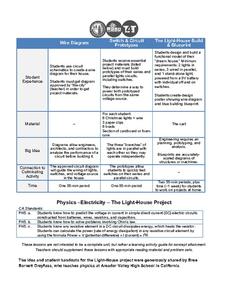University of California
Plankton
Plankton: so much more than just a SpongeBob character. Three different activities have kids looking at both phytoplankton and zooplankton in pictures, as well as collecting their own samples (depending on your access to a saltwater...
Trash For Teaching
The Light-House Project
Groups work together to design a lighthouse, from designing and drawing the wiring diagram, to creating prototypes of the switch and circuit, to envisioning and building a scale model along with a blueprint. By including different...
NASA
Launch It
Launching a rocket with a balloon—that sounds crazy! The class brainstorms design characteristics of a rocket. Individuals build a balloon launcher and a rocket straw. Using the air stored in a balloon, the individuals launch their...
Chicago Botanic Garden
Faces of Climate Change
You know global warming is real when your squirrel feeder is full of popped corn instead of kernels! Activity two in a series of five allows learners to explore climate change through the eyes of another. After briefly analyzing their...
Chicago Botanic Garden
Food for Thought: Climate Change and Trophic Cascades
Learners examines the arctic food web with a short video about polar bears and an article about bears and warming temperatures. They design an arctic food web and discuss the trophic cascade that could come from climate change.
Science 4 Inquiry
The Ins and Outs of Photosynthesis
The most important chemical process on Earth is photosynthesis. Scholars explore the changes in the gases in our atmosphere as life on Earth developed. They create a model of photosynthesis and consider simple questions.
Baylor College
About Air
Give your class a colorful and tasty representation of the components of the mixture that we call air. Pop a few batches of popcorn in four different colors, one to represent each gas: nitrogen, oxygen, argon, and carbon dioxide. The...
Other popular searches
- Reading Guide
- Active Reading Guide
- Anticipation Guide Reading
- Independent Reading Guide
- Selective Reading Guide
- Nonfiction Reading Guide
- The Outsiders Reading Guide
- Outsiders Reading Guide
- Three Level Reading Guide
- Reading Using Guide Words
- Reading Guide "Night"
- Reading Study Guide








